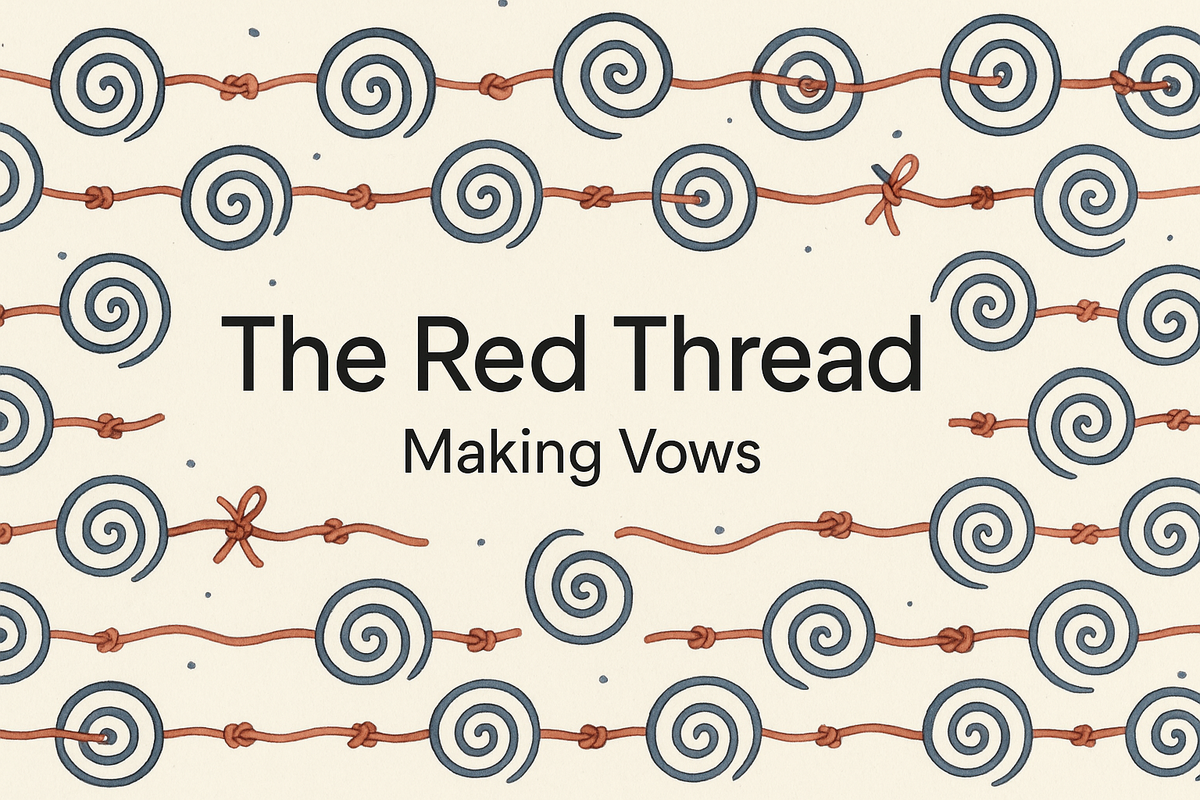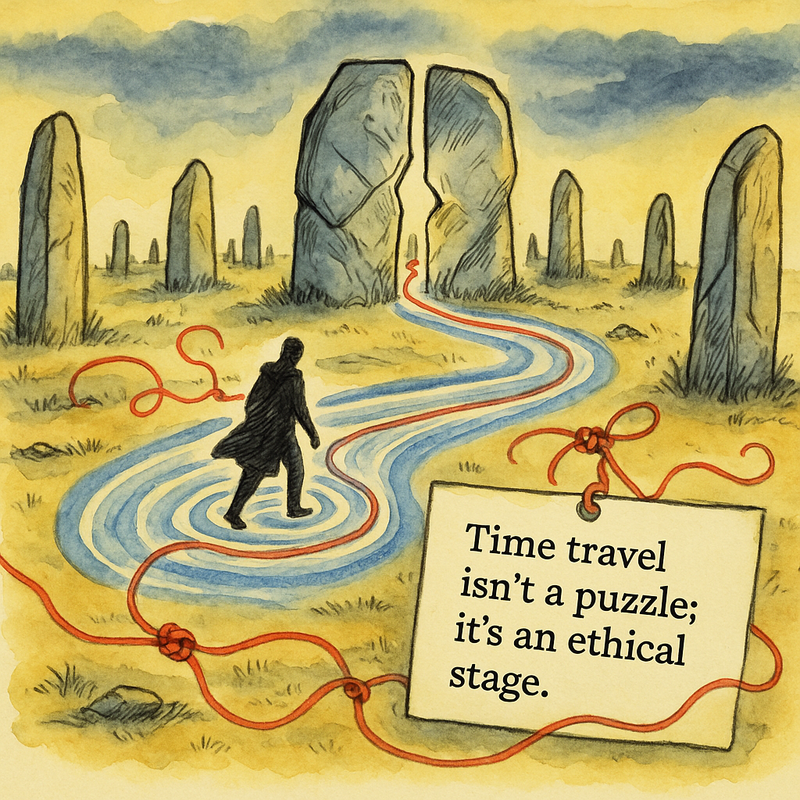The Secret Language of Outlander: How Spirals and Threads Reveal a Story of Choice, Not Fate — Sassenach Studies S01E01 Companion
November 5, 2025•999 words
Listen/Watch/Read: Episode audio · Episode video · Transcript
Introduction: Beyond the Romance
For many, Outlander is a sweeping epic of destiny—a story of fated lovers pulled together across time, their romance the fixed point in a turning world. But to see the story as one of predestination is to miss the intricate, visual argument the show makes in almost every frame.
Beneath the romance and time-traveling adventure, the series uses a subtle but persistent visual language to tell a deeper story. This isn't a narrative about the inevitability of fate, but about the immense weight and rippling consequence of human choice. The key to understanding it lies in two recurring shapes that function as the show’s thinking tools: the spiral and the thread.
1. The Hidden Grammar: Spirals Widen, Threads Bind
The show’s two most important visual motifs, spirals and threads, are not mere decoration; they are its narrative grammar, organizing the moral stakes of every major event.
The spiral appears in ancient stone carvings, the curl of smoke from a fire, and in the slow, orbiting movements of the camera. Its function is to widen the story’s scope. When a spiral enters the frame, it stages concurrence, allowing past and present to sit together like tree rings. This keeps the romance situated within history, not outside it. A spiral is a "field of force" that distributes responsibility, pulling characters, their kin, and their country into a shared pattern of consequence.
The thread, by contrast, tightens the story’s focus on commitment. Appearing in sutures, ribbons, knots, and sashes, it binds. Where the spiral broadens, the thread makes vows and obligations visible, tangible, and accountable. This is techne—the skilled making of bonds. In the wedding scene, for instance, the priest’s strip of tartan binding Claire and Jamie’s hands turns a promise into an object the camera can revisit. This "craft turned covenant" has two key properties: friction, as material promises snag and resist easy reversal; and persistence, as textiles travel across seasons and episodes, keeping choices in circulation.
Together, these shapes create a dynamic system: spiral connects across time; thread commits in time.
2. Time Travel Isn't a Puzzle, It's an Ethical Stage
Most time-travel stories treat the past as a puzzle to be solved. Outlander rejects this premise. Here, time travel is reframed as an "ethical stage," a platform where character is tested not by paradoxes but by responsibility. The central question shifts from "Can we change history?" to a much more difficult one: "What obligations travel with us, and who pays the price for our actions?"
This approach couples the scope of the spiral with the binding of the thread. The spiral widens the ethical stage, forcing characters and viewers to see the full circumference of people affected by a single anachronistic choice. Simultaneously, the thread represents the pre-existing vows—a doctor’s oath, clan loyalties, a wedding band—that constrain action on that stage. This dynamic grounds the fantasy in a stark moral realism and prevents hindsight heroics; knowing the future doesn't grant immunity from duty, it only increases the weight of justification. Claire’s medical interventions are a perfect case study: her modern knowledge widens her responsibility (spiral), but her oaths and the material limits of the 18th century constrain her every move (thread).
3. Patterns Attract, But Choices Inscribe
While the story is rich with prophecies and omens, these are consistently presented as atmospheric pressures, not predestination. The show carefully distinguishes between "pattern cues" that set a mood and "choice markers" that create a binding reality. Its core argument is that characters write their own moral lines through deliberate acts—their "threading" of commitments into the world.
Patterns attract, but choices inscribe.
This distinction is a powerful and clarifying lens. It protects the agency of every character by guiding the viewer to look past the alluring patterns of fate and instead evaluate the accountability behind each major decision. The show trains us to see that while prophecies may draw people together, it is the tangible choice markers—the exchanged tokens, the sworn vows, the hands that reach across a threshold—that write the lines they must live by.
4. Agency Is in the Hands
One of the most surprising details for viewers to notice is the show’s recurring "hands-before-crossings" motif. Time and again, just before a character crosses a significant threshold—be it the standing stones, a doorway, a bedside, or a battle line—the camera will pause on their hands.
This visual habit is a powerful tool for consent marking. It makes assent visible and deliberate, shrinking grand, historical stakes down to the accountable scale of human touch. But more importantly, these repeated micro-gestures function as a form of agency training for the audience. They teach us to read choice not as a loud, dramatic spectacle but as a quiet, owned habit. The gesture of reaching, hesitating, or grasping turns a character's private intent into a tactile, observable action, insisting that major crossings are chosen, not fated.
Conclusion: A New Way to Watch
Outlander's visual language offers a remarkably sophisticated story about the interplay between historical forces and personal accountability. It teaches us to see the world not as a line of fated events, but as a fabric woven from countless individual commitments. The spiral reveals the vast field of consequence, while the thread reminds us that every significant line within it was drawn by choice.
Crucially, the narrative scores these decisions. The spiral ensures the story will always return to the site of an action to tally its cost, testing the strength of every thread. It is a system that holds characters accountable not for what was foretold, but for what they chose to bind and what they dared to cut. As you watch, ask yourself: what moral line is being written into the world by this choice, and where will the spiral return to show us the price?
Links: Episode audio · Transcript · Episode Guide



